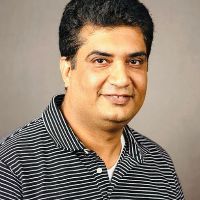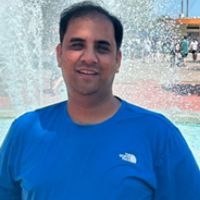The CURE Experience
Hear from Users!
We sent questions to our CURE users about their experience. Read below for their testimonies, and we thank them for their responses.
Dr. Umesh K. Reddy, Ph.D
Dr. Umesh K. Reddy - Professor of Biology, Director of Biotechnology Graduate Program - West Virginia State University
- How did you learn about the Center for Ultrastructural Research (CURE), FVSU?
We became aware of CURE at FVSU through academic collaborations, professional networks, and recommendations from colleagues working in plant structural biology and microscopy. The facility's reputation for high-quality imaging and its accessibility for researchers interested in plant ultrastructure played a significant role in our decision to use its services.
- What kind of research did you carry out at CURE, FVSU?
Our research at CURE focused on the analysis of trichome morphology in tomato and watermelon using scanning electron microscopy (SEM). Specifically, we examined trichome length and structural changes under different experimental conditions, aiming to understand their role in plant defense and adaptation.
- How was your experience with CURE, FVSU?
Our experience with CURE was excellent. The facility provided state-of-the-art equipment and a well-organized workflow that allowed us to obtain high-resolution images efficiently. The support from the technical staff was invaluable in optimizing our imaging protocols and ensuring accurate data collection.
- How was your experience with our Lab Manager, Ms. Pawar?
Ms. Pawar was highly professional, knowledgeable, and supportive throughout our research process. She provided thorough guidance on sample preparation, instrument settings, and image acquisition, which significantly enhanced the quality of our results. Her responsiveness and willingness to assist made the experience smooth and productive.
- Will you use this facility in your future research?
Yes, we would be interested in using CURE for future research, particularly for further investigations into plant surface structures, stress responses, and comparative ultrastructural studies of various crop species.
- We have added transmission electron microscope, atomic force microscope, cryotome facility, in addition to a scanning electron microscope. Do you see yourself using them?
Absolutely. The addition of a transmission electron microscope (TEM) and atomic force microscope (AFM) expands the range of analyses we can conduct. TEM would allow us to study intracellular structures at a higher resolution, while AFM could provide insights into nanomechanical properties of plant surfaces. The cryotome facility is also valuable for preserving delicate biological samples for high-resolution imaging.
- How can we make our service better to suit your needs?
One way to enhance the service would be to offer tailored workshops or short training sessions on advanced imaging techniques for plant biologists. Additionally, an option for remote access or virtual assistance for image processing and analysis would be beneficial.
- Would you like your graduate/PHD students to receive a basic training course at CURE for a fee?
Yes, we would be interested in having our graduate and PhD students receive a structured training course at CURE. Hands-on experience with SEM, TEM, and AFM would be highly beneficial for their research and skill development, making them more proficient in structural analysis techniques.
Dr. Shahid, Muhammad Adnan
Dr. Shahid, Muhammad Adnan - Assistant Professor of Horticulture - North Florida Research and Education Center
- How did you learn about the Center for Ultrastructural Research (CURE), FVSU?
Professor Dr. Nirmal Joshee from the College of Agriculture, Family Sciences, and Technology
- What kind of research did you carry out at CURE, FVSU?
At CURE, we use SEM technology for our citrus experiment. We at North Florida Research and Education Centre work on cold, hardy citrus in different ways. Recently, we used the SEM for our combined drought and cold stress experiment.
- How was your experience with CURE, FVSU?
It was amazing, especially the staff and people at the facility who guided us. The overall experience, from sample delivery to results, was great.
- How was your experience with our Lab Manager, Ms. Pawar?
My experience with Ms. Pawar was great. She is very dedicated to her work. During my first experience, I learnt a lot from her; she taught me everything about SEM study.
- Will you use this facility in your future research?
Yes, this is an excellent opportunity for us to use this facility in future research and a good chance of collaborating with this institute.
- We have added transmission electron microscope, atomic force microscope, cryotome facility, in addition to a scanning electron microscope. Do you see yourself using them?
Until now, we have only used SEM, but we are willing to use these facilities to empower our research findings with this fantastic technology in future experiments.
- How can we make our service better to suit your needs?
As I feel, with the analysis result, please provide a brief description of the procedure and methods, and a little information about the results.
- Would you like your graduate/PHD students to receive a basic training course at CURE for a fee?
Yes, basic training at CURE is much more beneficial for graduates/postdocs interested in this research field. I discussed the short training opportunity with Ms. Pawar during my last visit.
Dr. Shahid Iqbal
Dr. Shahid Iqbal - Post-Doctoral Fellow - North Florida Research and Education Center
- How did you learn about the Center for Ultrastructural Research (CURE), FVSU?
I learned about the Center for Ultrastructural Research (CURE) at FVSU while researching institutions involved in advanced biological imaging. I came across the CURE through the FVSU website here and was impressed by the center's focus on electron microscopy and its role in student training and scientific research. I reached out to Dr. Joshee to inquire about the possibility of utilizing the facility for our research projects. After discussing the details of our work, Dr. Joshee kindly agreed to support our efforts.
- What kind of research did you carry out at CURE, FVSU?
At CURE, our research focused on understanding the effects of abiotic stresses, such as drought, heat, cold, and salinity on plant systems, particularly in citrus. These stress factors significantly impact plant health, and scanning SEM are essential tools for analyzing their effects at the Ultrastructural level. Recently, CURE supported our work by providing SEM imaging of leaf samples from an experiment investigating the impact of drought and cold stress in citrus. The high-resolution images obtained were critical for assessing stress-induced changes in cellular and subcellular structures, helping us gain deeper insights into plant responses.
- How was your experience with CURE, FVSU?
My experience with CURE at FVSU has been extremely positive and productive. The facility is well equipped with advanced imaging technologies, and the staff is highly knowledgeable and supportive. Dr. Joshee and his team were very collaborative and responsive throughout the process, providing valuable guidance during the SEM imaging of our citrus lead samples. Their expertise greatly enhanced the quality of our research, and the data we obtained has been instrumental in advancing our understanding of plant responses to abiotic stress. Overall, working with CURE has been a rewarding experience, and I look forward to future collaborations for joint-venture research projects.
- How was your experience with our Lab Manager, Ms. Pawar?
My experience working with Ms. Pawar, the Lab Manager at CURE, was excellent. She was incredibly helpful, organized, and knowledgeable about the lab's equipment and procedures. Ms. Pawar ensured that our SEM imaging session went smoothly, provided clear guidance on sample preparation and imaging protocols, and was always available to answer questions or offer technical support. Her professionalism and attention to detail played a key role in the success of our work at CURe, and I truly appreciated her collaborative and supportive approach.
- Will you use this facility in your future research?
Yes, I definitely plan to use the CURE facility in my future research. The advanced imaging capabilities, particularly SEM and TEM, are essential tools for our studies on the effects of abiotic stresses on plant ultrastructure. The high-quality data we obtained from our recent work at CURE significantly enhanced our analysis, and the collaborative environment made the entire process efficient and productive. I look forward to continuing this partnership and utilizing the facility for future projects that require detailed cellular and subcellular investigations.
- We have added transmission electron microscope, atomic force microscope, cryotome facility, in addition to a scanning electron microscope. Do you see yourself using them?
I definitely see the potential to utilize the additional equipment now available at CURE. The transmission electron microscope (TEM) will be especially valuable for exploring detailed subcellular structures that aren't visible with SEM alone, which is crucial for our work on stress-induced changes in plant cells. The atomic force microscope (AFM) opens up exciting opportunities to study surface topography and mechanical properties at the nanoscale, which could complement our current research directions. Additionally, the cryotome facility would allow us to prepare ultra-thin sections of tissues while preserving cellular integrity, particularly useful for high-resolution imaging of sensitive samples. These additions significantly expand the scope of what we can investigate, and I look forward to integrating them into our future research projects.
- How can we make our service better to suit your needs?
My overall experience with CURE has been excellent, and I truly appreciate the support and resources provided. To further enhance the user experience, offering more hands-on training sessions or workshops on advanced imaging techniques, such as TEM, AFM, and cryo-sectioning would be highly beneficial, especially for researchers and students who are new to these methods. Implementing more flexible scheduling options or an online booking system could also help streamline access to the facility. Lastly, maintaining open lines of communication and opportunities for user feedback like this survey are valuable in ensuring the facility continues to meet the evolving needs of its research community.
- Would you like your graduate/PHD students to receive a basic training course at CURE for a fee?
Yes, I would absolutely be interested in having my graduate and PhD students receive a basic training course at CURE, even if it involves a fee. Gaining hands-on experience with advanced imaging techniques such as SEM, TEM, AFM, and cryo-sectioning would be incredibly valuable for their academic and professional development. A structured training course would not only enhance their technical skills but also improve the quality and efficiency of their research. I believe this kind of opportunity would greatly benefit students and strengthen collaborations with CURE.
Overall, I will say (my) experience with the Center for Ultrastructural Research (CURE) at FVSU has been exceptional. The facility is equipped with state-of-the-art imaging technologies, including scanning and transmission electron microscopes, atomic force microscopes, and a cryotome facility. These advanced tools have been crucial for our research on the effects of abiotic stresses on plant systems, particularly citrus. The quality of the data we obtained from CURE has significantly enhanced our research and contributed to a deeper understanding of plant stress responses at the cellular and subcellular levels. The staff at CURE, particularly Dr. Joshee and Lab Manager Ms. Pawar, were incredibly supportive and responsive throughout our work. Dr. Joshee's guidance and the technical expertise provided by Ms. Pawar were essential in ensuring our imaging sessions ran smoothly, with clear instructions on sample preparation and imaging protocols. Their professionalism and attention to detail were invaluable, and I truly appreciated the collaborative and efficient environment they fostered.
.jpg)

